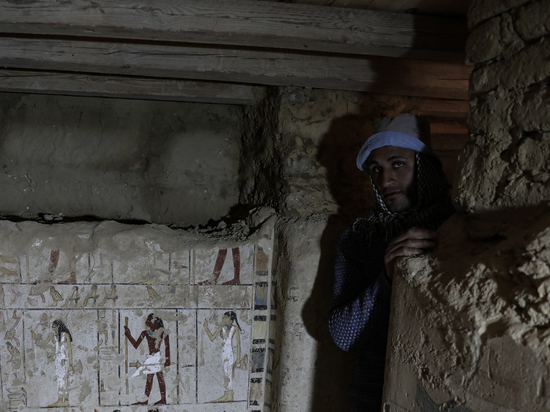Oldest ‘golden mummy’ found in Egypt turns out not to be a mummy
[ad_1]

The Egyptologist explained the significance of the find “near the pyramid of Djoser
In Egypt, next to the Step Pyramid in Saqqara, built by the famous architect Imhotep for the burial of Pharaoh Djoser, archaeologists have discovered a mummy covered with gold. The head of the excavation, an Egyptologist who once served twice as Egypt’s minister of antiquities, Zahi Hawass, said the remains were the oldest found to date, at about 4,300 years old. However, they strictly say that this is not about a mummy, Roman Orekhov, a leading researcher at the Center for Egyptological Studies of the Russian Academy of Sciences, explained to MK. The technology of covering the remains with gold is older than mummification, which began to be used only during the New Kingdom (from the 16th to the 11th centuries BC).
Egyptian media report that during excavations in a vast necropolis located in the Saqqara region and in close proximity to the ancient pyramid of Djoser, several sarcophagi and a number of wooden statues were found. The greatest interest among researchers was caused by the remains covered with gold, they belong to a man. They were found in a limestone sarcophagus at the bottom of a 50-foot-deep shaft.
– I was there with colleagues a year and a half ago. Obviously, the find was made in ancient mastabas – structures in the form of a bench, inside which there are long shafts that lead down and abut against burial chambers with sarcophagi, – Roman Orekhov, a leading researcher at the Center for Egyptological Research of the Russian Academy of Sciences, explains to MK. – The superstructure of the mastaba has not been preserved. It is surprising that a body covered with gold has been preserved. At that time, there were no mummies as such, at least those that appeared in the era of the New Kingdom. They made something like dolls, filling in parts of the body with inserts, or covered the body with gold. Thus the Egyptians emphasized that the flesh is sacred.
“In Egyptology, there is the only such example: in the 1950s, the French archaeologist Jean-Philippe Lauer discovered a bone covered with gold in the pyramid of Djoser, and decided that this was the bone of the pharaoh himself,” continues the interlocutor of MK. “The practice of covering the remains with gold is very ancient. Apparently, this person was close to the pharaoh or an important nobleman. Usually the remains of that period were not covered with anything. Most of the time they are in extremely poor condition. At best, they can be found on a diadem covered with gold or the so-called “orders of life” – the Egyptian symbol Ankh made of thin gold wire (a symbol of immortality). Thus, a person was ranked among the blessed. If the whole body was covered with gold, then the person was very well-deserved and important.
It is worth adding that the underground pyramid of Djoser from time immemorial was considered a sacred place for the Egyptians. The pharaoh, who ruled approximately in 2665-2645 BC, completed the unification of Upper and Lower Egypt, turning his kingdom into a single powerful state. He founded a new capital on the banks of the Nile – Memphis. Under him, the first solar calendar was introduced. And his closest assistant was the famous astrologer, sage and architect Imhotep, who, in fact, built the pyramid of Djoser – a large 6-step stone structure, the first of its kind.
“The officials who lived later honored this place and wished to be buried next to the great pharaoh,” concluded Roman Orekhov. – It was believed that the place of his burial has magical powers and protection in another life.
[ad_2]
Source link








